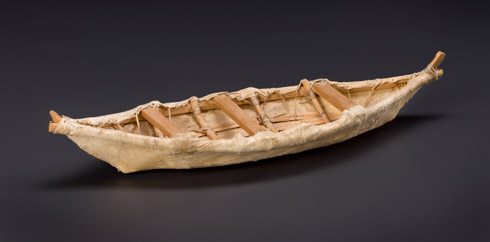About the Artifact

© Canadian Museum of Civilization, VI-I- 50, Photo Marie-Louise Deruaz, IMG2012-0171-0005-Dm
“Boats constructed of [a] wooden (or bone) frame with [a] skin covering have, in various shapes, a circumboreal distribution. There is reason to believe, however, that such vessels were used little, if at all, by the Peel River Kutchin [Gwich’in] prior to White contact and the inception of the fur trade. To be on the safe side, it would be better to stress ‘little’, rather than ‘at all’, since skin-covered boats are an ancient cultural tradition in the high latitudes.
The reason[s] it is believed that moose-skin boats were rare in pre-contact Peel River Kutchin culture are: (1) statements of aged and knowledgeable informants in 1938–39; (2) the present writer’s conviction that the Peel River people did little summer travelling on the Peel or any other large river until well after the arrival of the Europeans.
In this area, the moose-skin boat was a concomitant of the establishment of a yearly round of activities featuring a visit to the trading post, in this case Fort McPherson, by a significant number of the Peel River band. The boat became an important part of what the present writer has called ‘the regimen of the “Old Days”’.
The small flotilla of moose-skin boats that descended to Fort McPherson after break-up on the Peel was called, in frontier English, the ‘brigade’, in reminiscence of the brigades of freighting canoes and York boats that were a feature of the fur trade. With changing conditions after the end of the nineteenth century, the use of moose-skin boats diminished; after the rise to importance of muskrat hunting in the Mackenzie Delta, the boats became obsolete. The last ‘brigade’ of any size descended the Peel in 1922. Two boats descended the Peel in the spring of 1925, and no more thereafter.
The model boat made by Brian Francis is accurate in shape and fairly accurate, it would appear, as to the number of ribs. The covering is unrepresentational, however, as the full-size boats used fourteen to twenty skins. They were from 25 to 40 feet long [7.5 to 12 m].
The present writer saw moose-skin boats in use by Kutchin on the lower Chandalar River, in Alaska, in the summer of 1961. These were 8 to 12 feet [2.4 to 3.6 m] long, using all or parts of 6 to 10 skins. Sometimes winter caribou skins are used to eke out moose skins if these are in insufficient supply, but caribou skins are said to be inferior for the purpose.
The skins are treated in no special way before being stretched over the boat frame. They are not completely scraped on the underside, so as to leave a little fat as waterproofing, lubrication, and a sort of self-sealing against small punctures. Each boat is used for only one trip. When it reaches its destination downstream, it is broken up, the skins are thoroughly scraped and are then further treated (e.g., tanned) or sold.”
— Richard Slobodin, 1963–1964
“Moose-skin boats carry the natives down the Peel River in the late spring. They are always made with a frame of spruce because of the lightness of the wood, which is bent into shape while green. Raw, clean moose skins are used for the cover. Six or seven families may cooperate in the building of the boat, the men making the frame and the women sewing together about twelve skins with sinew thread in a manner which, according to a man’s description, sounds like Eskimo [Inuit] waterproof sewing.”
— Cornelius Osgood, 1936